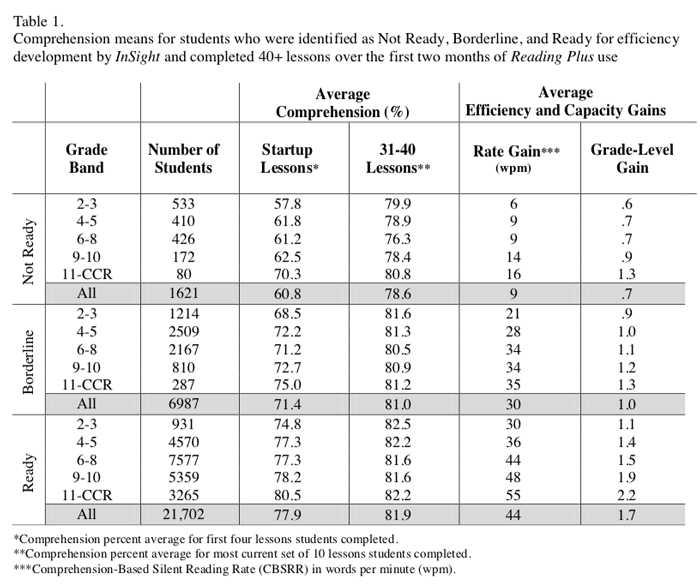
Purpose of Study:
Students with low comprehension, slow silent reading rates, and/or an impoverished vocabulary may not be ready for efficiency building in Reading Plus. Nevertheless, the program includes a wealth of texts that offer these challenged readers the critical practice they need to improve their comprehension, vocabulary, and stamina.
This study looks at how these low-performing students, deemed “Borderline” or “Not Ready,” progressed in Reading Plus during the first two months of the 2013-14 school year. We were especially interested in how the Borderline and Not Ready groups of students advanced when they were exposed to substantial amounts of text on a consistent basis, and how this progress compared to students who were deemed “Ready.”
Study Design:
We tracked the progress of more than 30,000 students in grades 2 through 12 who completed InSight, the Reading Plus reading assessment, and completed 40 or more reading practice lessons (about 10 hours) during the first two months of the school year. Of special interest was growth in comprehension level and efficiency in the Not Ready (n = 1,621), Borderline (n = 6,987), and Ready (n = 21,702) students.
Key Results:
All students increased their comprehension levels, with the largest increases measured in Not Ready and Borderline students (average comprehension gains of 17.8% and 9.6% respectively). All students also increased their reading efficiency, with the largest increases measured in the Borderline and Ready students (average silent reading rate gains of 30 and 44 words per minute respectively).
These encouraging results indicate that even low-performing readers can benefit from Reading Plus practice. Students in all three groups increased capacity to read more complex text efficiently. Further, these gains were made in a short period of time (approximately 10 hours). All this suggests that closing the gap between where students are in their reading development and where they are expected to be (according to Common Core standards) is an achievable goal when they are provided with consistent and well-designed opportunities to read.

